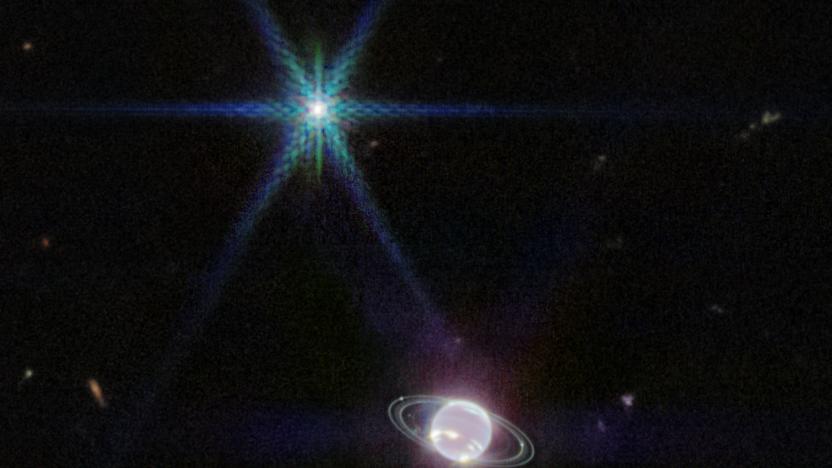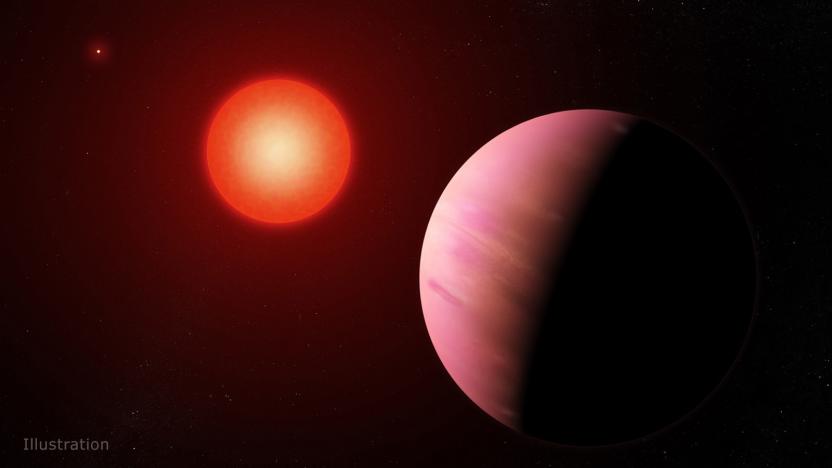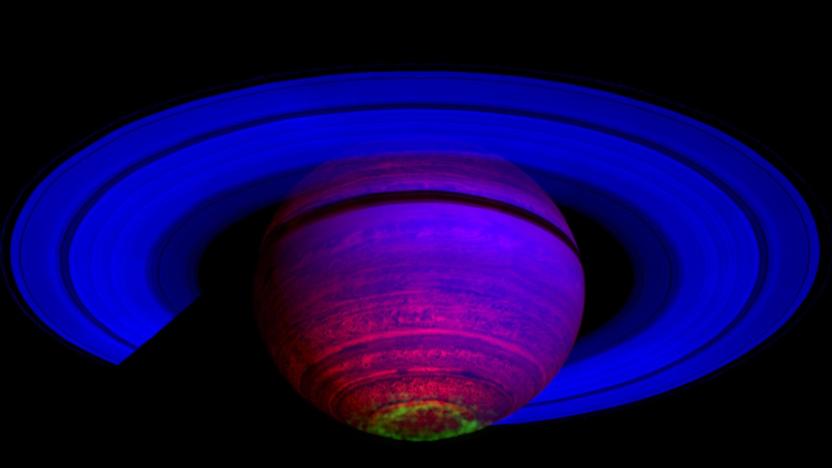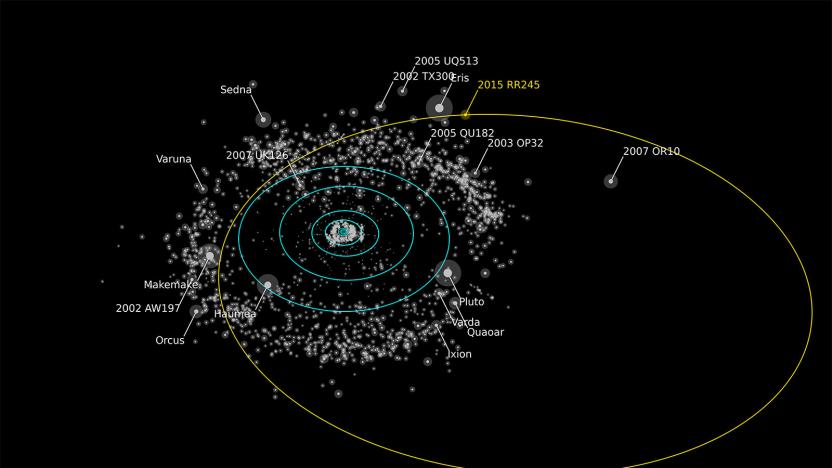Neptune
Latest

James Webb Space Telescope captures the best image of Neptune's rings in decades
The James Webb Space Telescope has captured its first image of Neptune, and it's the best view of the planet's rings in over 30 years.

Valve is reportedly prototyping a Nintendo Switch-like gaming PC
Evidence that Valve is working on a portable Switch-like device that will allow Steam users to play part of their game library on the go is starting to pile up.

Potential NASA mission would explore Neptune's moon Triton
A proposed NASA mission would explore Neptune's moon Triton and solve some longstanding riddles.

NASA gives four projects $3 million to develop potential space missions
NASA has announced four projects as part of its Discovery Program, which sees the space agency asking scientists to pitch focused, relatively low-cost missions for it to take on and develop into full-fledged missions. "Although they're not official missions yet and some ultimately may not be chosen to move forward, the selections focus on compelling targets and science that are not covered by NASA's active missions or recent selections," NASA writes on its website.

Citizen astronomers discover new planet that NASA algorithms missed
NASA's Kepler Space Telescope might not be doing much anymore, but discoveries are still being made thanks to the data it left behind. By analyzing its historical records, and crowdsourcing help from volunteer astronomers, a citizen team has discovered a new planet roughly twice the size of Earth. The planet, known as K2-288Bb, could be rocky, or gas-rich, similar to Neptune. Its discovery is particularly exciting because the planet's size (just slightly smaller than Neptune) is so rare among those beyond our solar system – known as exoplanets.

What's next for NASA as Cassini's mission comes to a close
After nearly two decades in space and 11 years studying Saturn (and its myriad moons), the Cassini spacecraft ended its mission at roughly 6:30 am Eastern on Friday when it slammed into the gas giant's suffocating atmosphere. It was an auspicious end for the $3.4 billion spacecraft, argues Curt Niebur, the program scientist for Cassini at NASA headquarters. "I find it exhilarating, myself," he said. "Instead of just crashing it into something and saying we're done, we're actually going after science questions that we never intended Cassini to answer. And we'll be able to address those. It's fantastic."

Scientists recreate Neptune's diamond rain using powerful lasers
While we've yet to fully explore Neptune and its fellow gas giants, scientists have a lot of theories about them based on the info we know. For instance, they believe that it rains diamonds on those planets -- diamonds that sink into their interior and form a sparkly crust around their solid cores. Since it might take a long time before we can study our gas giants more closely, a team of researchers have decided to take matters into their own hands. They recreated Neptune's conditions at Stanford's SLAC Laboratory and successfully observed the formation of diamond rain, thanks to the help of some very powerful lasers.

There's something weird going on beyond Neptune
Past Neptune, in the outer solar system, astronomers have recently discovered a new mystery object orbiting the sun on a plane nearly perpendicular to the rest of the planets. Adding to the weirdness, the trans-Neptunian object, which has been nicknamed "Niku," is also spinning around the sun backwards, in the opposite direction of the rest of the planets. So far, astronomers have little idea what could cause such abnormal celestial behavior.

Hawaiian telescope spots a new dwarf planet beyond Neptune
Just beyond Neptune lies a ring of small, icy worlds that offer insight into the formation of our Solar System, and scientists using the Canada-France-Hawaii Telescope on Maunakea, Hawaii, just discovered a new dwarf planet in this region that rivals Pluto and Eris in visibility. It's called RR245 and in this case, size matters -- many of the worlds in the farthest reaches of the Solar System are too small and dull for Earthbound scientists to study. Basically, when it comes to post-Neptune dwarf planets, the bigger and brighter, the better.

Hubble discovers a new 'dark vortex' on Neptune
Researchers gazing through NASA's hardworking, time-bending Hubble space telescope spotted a new storm brewing on Neptune last month. As the space agency confirmed today, research astronomers analyzing telescope data at the University of California at Berkeley discovered a new "dark spot" on the planet — only the third since Voyager 2 first spotted one in during its 1989 flyby.

Neptune outs dumb screens, accessories for its weirdo wrist computer
Technology is all about big ideas, and this one from Simon Tian will probably need its own aircraft hangar. The creator of the Neptune Pine believes that it's time for us to ditch our smartphone, laptop and set-top-box in favor of the Neptune Hub. As we reported, the Neptune Hub is a wrist-worn computer that crams the guts of a smartphone into a chunky plastic bracelet. Instead of using the hardware as a phone, however, users are encouraged to bring along a dumb screen that connects to the Hub. But that's the beginning of Tian's idea, not the end.

Behold: a wristband that replaces your phone with a dumber phone
The folks behind the giant and retro (but not quite useful) Neptune Pine smartwatch are back -- and this time they're aiming to flip technology paradigms. Their new product, the Neptune Duo, is made up of two familiar looking devices that don't work the way you'd expect. The Neptune Hub is a chunky wristband that actually houses all of the technology you'd normally find in a smartphone, and it's accompanied by the Neptune Pocket, a 5-inch screen that just serves as a wireless dummy display for the Hub. The idea, according its 20-year-old creator Simon Tian, is to evolve our relationship with wearables by putting your primary device on your wrist. The only problem? Tian still isn't quite clear on why, exactly, you'd want to do that.

Here's what it's like to use a watch as a phone
No one wants the smartwatch category to succeed more than I do. As a kid, I dreamed of enjoying TV on my watch, or video calling "HQ" (or more likely, my mum), just like Penny in Inspector Gadget. Most smartwatches offer a taste of this experience, but not the whole enchilada. Enter Neptune Pine. It's a smartwatch by the loosest definition: it's a small Android phone in a wrist-strap. Whatever you want to call it, it'll do both of the above things, and more. It's also a genuine Kickstarter success story -- like, one, where the product came out and everything! It might not be the first smartwatch/phone mash-up, and it's (definitely) not the last. But, it's one of the more ambitious takes on the idea I've seen. I spent seven days with it (and no other phone) to see how my dream stands up to the reality -- and whether a watch could ever replace your trusty mobile. The galleries tell much of the story, so be sure to jump in when you see them.

The Big Picture: Neptune's largest moon, Triton
Neptune has more moons than we have planets in our Solar System, with a total of 14 (and counting) orbiting around it. Its largest, Triton, is big enough to practically be considered a planet, so much so that scientists often compare it to Pluto. (You know, the planet which isn't really a planet, but some people think it should be a planet? Yeah, that's the one.) Now, courtesy of old NASA footage from the Voyager 2 spacecraft, we're getting a closer look at Triton and how it looked back in 1989. Not only that, but NASA's taken images from the aged trek and used them to create the best global map of Triton yet, with color schemes which "are a close approximation to Triton's natural colors." The map, according to NASA, features a resolution of 1,970 feet per pixel, which makes for very, very interesting viewing action.

Neptune's Pine isn't a smartwatch; it's a smartphone that sits on your wrist
When designing a smartwatch, the general trend is to start with a basic timepiece and add features until physics or budgets get in the way. That's not the approach taken by 19-year-old Canadian Simon Tian when he developed the Pine by Neptune. Instead, he took to Kickstarter with the idea of just shrinking a last-generation smartphone down to watch-size proportions. The result isn't really a watch in any sense of the word, but considering that the Pine raised eight times its goal on Kickstarter, there's clearly a desire for this sort of hardware. We got to spend some time with it at CES and want to share some impressions with you.

NASA and SETI discover new Neptunian moon, spot what Voyager 2 missed
A baker's dozen worth of moons might already sound like too many for us Earthlings, but Neptune has just had its count bumped to 14. Though the extra luna appeared as a white dot in over 150 photos taken by NASA's Hubble telescope between 2004 and 2009, it took SETI's Mark Showalter to discover it after poring over images of faint rings around the planet. Dubbed S/2004 N 1, the satellite is no more than 12 miles across and completes its orbit every 23 hours. Hoping to spot it in the night sky? You're better off hitting the second source link for more pictures, as it's 100 million times dimmer than the faintest star viewable with the naked eye, and it escaped Voyager 2, to boot. [Image credit: NASA, ESA and A. Feild (STScI)]

Trouble hearing? Advanced Bionics' waterproof implant is paddling your way
If you're one of the 200,000 deaf people who've received cochlear implants, then here's an upgrade worth considering: the Neptune from Advanced Bionics claims to be "the world's first and only swimmable, waterproof sound processor," and it's just received certification for the US and Canada. Read on for more details in the full press release and soon you could be bantering while you bathe.

Hyper Dimension Game Neptune: An RPG on consoles, starring consoles
Hyper Dimension Game Neptune, a new PS3 RPG revealed in Famitsu magazine, puts players in the role of a personified video game console in the fight against piracy. Neptune is a fictional video game console turned into a girl, on a quest to defeat the "Goddess Majicon" -- "Majicon" being the Japanese term for DS flash carts like the R4. The concept calls to mind not only the "Console-tan" or "OS-tan" meme, in which computer operating systems and video game consoles are drawn as anime-style girls, but also Sega's utterly bizarre Dreamcast game Segagaga, in which Sega characters live and work at Sega -- a game that ends with a battle against flying Sega consoles. It's worth noting that "Neptune" was also the name of a proposed Genesis/32X console.

Neptune's Trident case mod honors the god of liquid cooling
What do you do if your Battlestar Galactica case mod has conquered Earth and space with its awesomeness? Why, you conquer the seas, of course. Brian Carter is back with this Neptune's Trident mod, a lovely blue thing with three separate cooling loops, one for each of the three EVGA GeForce GTX260 video cards inside. The result? A powerhouse for sure and something that we think would look quite appropriate in Tron Legacy. You reading this, Mr. Bridges?













